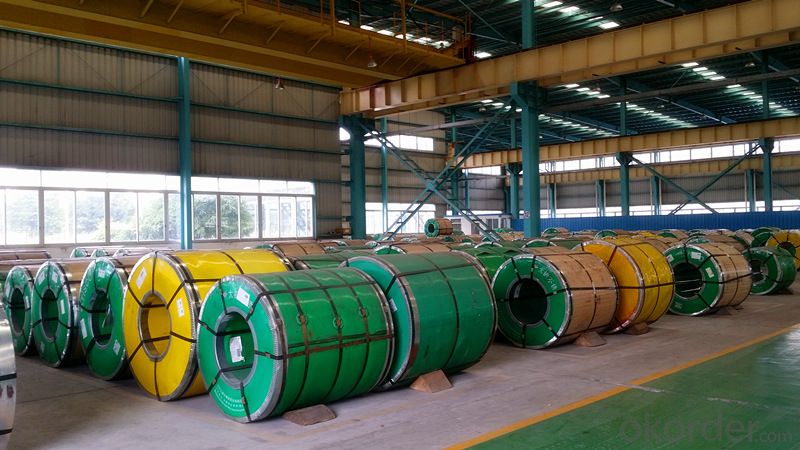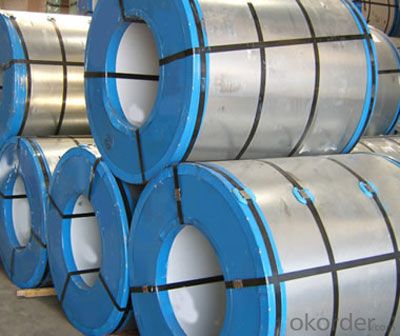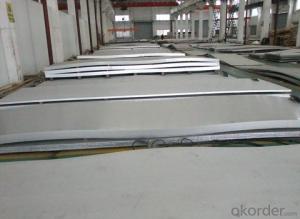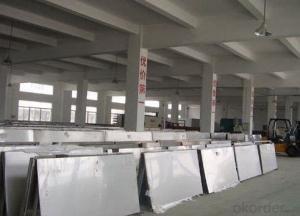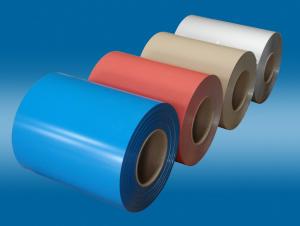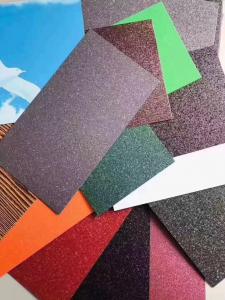Rusted Stainless Steel Sheets - Hot Rolled Stainless Steel Coil 403 2B/BA
- Loading Port:
- Tianjin
- Payment Terms:
- TT OR LC
- Min Order Qty:
- 100 m.t.
- Supply Capability:
- 10000 m.t./month
OKorder Service Pledge
OKorder Financial Service
You Might Also Like
1.Structure of Stainless Steel Coil:
Stainless steel coil is a production which not easy rust, acid resistance and corrosion resistance, Stainless steel coil is a new kind of Austenite stainless steel by used Mn, N replace Ni. so it is widely used in light industry, heavy industry, daily necessities and the decoration industry. Stainless steel coil has good corrosion resistance and hot / cold processing performance, instead of stainless steel products for used in the not high of corrosive environment, such as indoor, inland city outdoor etc.
2.Main Features of the Stainless steel coil:
1) High Quality: Using Latest automated control equipment to ensure the quality
2) Best Price: With most automated equipments to ensure our price is lower than the market
3) Fast Delivery: The delivery date within 20 das after get your order
4) Best Service: Our after-sell service team will help you to slove all the problems about the order
3. Stainless steel coil Images
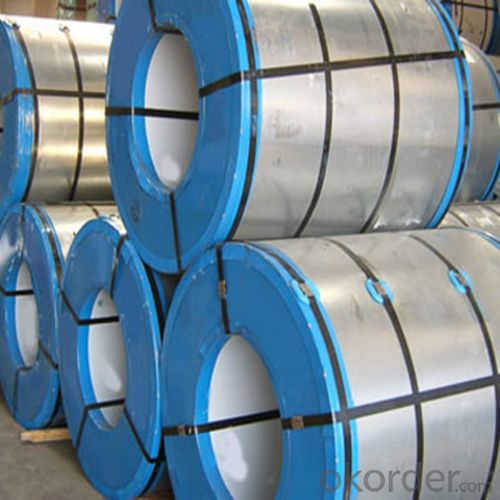

4. Stainless steel coil Specification
Product name: 304 Stainless Steel Coil
Thickness: 0.2mm to 1.5mm
Technical: Cold Rolled
Width: 10mm to 1240mm
Type: 200 Series
Length: As customer's requested
Standard: JIS, SUS
Finish: BA, 2B, 8K, NO.3, NO.4, HL
MOQ: 100 MT
Ship Term: FOB Shenzhen port or CNF import port
Delivery Time: 15 to 20 day after the receive the deposit or LC
Packaging: By wooden pallet, wooden case or according to customer's request
5.FAQ
1) How about your company?
2) A world class manufacturer & supplier of castings forging in carbon steel and alloy steel,is one of the large-scale professional investment casting production bases in China,consisting of both casting foundry forging and machining factory. Annually more than 8000 tons Precision casting and forging parts are exported to markets in Europe,America and Japan. OEM casting and forging service available according to customer’s requirements.
3) How to guarantee the quality of the products?
4) We have established the international advanced quality management system,every link from raw material to final product we have strict quality test;We resolutely put an end to unqualified products flowing into the market. At the same time, we will provide necessary follow-up service assurance.
- Q:What is the density of stainless steel sheets?
- The density of stainless steel sheets may differ based on the particular grade and thickness of the sheet. Nevertheless, stainless steel sheets generally possess a density of approximately 8,000 kilograms per cubic meter (kg/m³) or 8 grams per cubic centimeter (g/cm³). This elevated density is among the factors contributing to stainless steel's reputation for strength and durability.
- Q:What is the bending strength of stainless steel sheets?
- The bending strength of stainless steel sheets can vary depending on the specific grade and thickness of the sheet. However, stainless steel is generally known for its high strength and rigidity, making it suitable for various applications that require strong and durable materials.
- Q:What are the common methods of cutting stainless steel sheets?
- There are several common methods of cutting stainless steel sheets, each with its own advantages and limitations. Here are a few commonly used methods: 1. Shearing: Shearing involves using a machine with two blades to slice through the stainless steel sheet. This method is suitable for thinner sheets and produces clean, straight cuts. However, it may leave a slight burr on the edge of the cut. 2. Plasma cutting: Plasma cutting is a versatile method that uses a high-temperature plasma arc to melt and blow away the metal. It is effective for cutting stainless steel sheets of various thicknesses and shapes. Plasma cutting provides fast, precise cuts and can handle both straight and curved lines. 3. Laser cutting: Laser cutting uses a focused laser beam to cut through stainless steel sheets. It is highly accurate and produces smooth, precise cuts with minimal distortion. Laser cutting is suitable for both thin and thick sheets, but it can be slower than other methods for thicker materials. 4. Waterjet cutting: Waterjet cutting involves using a high-pressure stream of water mixed with abrasive particles to cut through stainless steel. This method is precise and can handle various thicknesses and shapes. Waterjet cutting is known for its clean edges and the ability to cut without heat-affected zones. However, it may be slower than other methods and can be more expensive. 5. Sawing: Sawing is a traditional method that involves using a saw blade to cut through stainless steel sheets. It is suitable for thicker sheets and can handle both straight and curved cuts. Sawing produces relatively clean cuts but may result in more material waste compared to other methods. These are just a few of the common methods used to cut stainless steel sheets. The choice of method depends on factors such as the thickness of the sheet, desired cut quality, shape complexity, and budget. It is important to consider the specific requirements of the project and consult with professionals to determine the most suitable cutting method.
- Q:What is the difference between stainless steel sheets and regular steel sheets?
- Stainless steel sheets and regular steel sheets differ primarily in their composition and properties. Stainless steel sheets are made primarily of iron and contain a minimum of 10.5% chromium, which gives them their unique stainless properties. Regular steel sheets, on the other hand, are made primarily of iron and carbon, with no significant amount of chromium. The presence of chromium in stainless steel sheets provides several distinct advantages. Firstly, it enhances the corrosion resistance of the material, making it highly resistant to rust and staining. This makes stainless steel sheets suitable for applications in environments where moisture or exposure to corrosive substances is a concern, such as in the food and beverage industry or marine applications. Additionally, stainless steel sheets have excellent heat resistance, making them suitable for high-temperature applications. They can withstand extreme temperatures without losing their structural integrity, which regular steel sheets may not be able to tolerate. Another key difference lies in the appearance of the two materials. Stainless steel sheets have a bright, reflective surface due to their chromium content, giving them a lustrous and modern look. Regular steel sheets, on the other hand, have a duller and less polished appearance. Furthermore, stainless steel sheets are often more expensive than regular steel sheets due to the additional manufacturing processes and the higher cost of the chromium alloy. However, the enhanced corrosion resistance and durability provided by stainless steel sheets can often justify the higher cost in various applications. In summary, stainless steel sheets differ from regular steel sheets in terms of their composition, properties, appearance, and cost. Stainless steel sheets offer superior corrosion resistance, heat resistance, and a visually appealing surface, making them ideal for specific applications where these attributes are required. Regular steel sheets, on the other hand, are more affordable but lack the unique properties of stainless steel.
- Q:Can stainless steel sheets be used for swimming pool construction?
- Yes, stainless steel sheets can be used for swimming pool construction. Stainless steel is a durable and corrosion-resistant material, making it suitable for withstanding the harsh conditions of a swimming pool environment. It is commonly used for constructing pool walls, floors, and other structural components.
- Q:Can stainless steel sheets be used for architectural column covers?
- Certainly, architectural column covers can indeed utilize stainless steel sheets. The selection of stainless steel is frequently made due to its commendable qualities of durability, resistance to corrosion, and its appealing aesthetic. Such a material can impart a sophisticated and contemporary appearance to architectural structures. Furthermore, stainless steel is obtainable in a range of finishes, including brushed or polished, enabling customization and facilitating design flexibility. The fabrication and installation of stainless steel sheets as column covers is a straightforward process, offering both protection and ornamentation to the structural columns within architectural endeavors.
- Q:What does "stainless steel plate" 6.0*1500c mean?
- 1. PTFE/Pb mixture, 0.01-0.03mm, an abrasion resistant material that, during operation, forms a transfer film to protect the grinding shaft.2. copper powder layer, 0.20-0.35mm, to improve the bonding strength of PTFE/Pb and copper plate layer, has good bearing capacity and wear resistance. Higher thermal conductivity allows rapid transfer of heat generated during operation.3. stainless steel substrate, improve the bearing capacity and heat transfer, and have better corrosion resistance.
- Q:Are stainless steel sheets suitable for water treatment facilities?
- Yes, stainless steel sheets are highly suitable for water treatment facilities. Stainless steel is corrosion-resistant, durable, and can withstand harsh conditions often found in water treatment processes. Additionally, stainless steel sheets are hygienic, easy to clean, and do not react with water or chemicals, making them an ideal choice for such facilities.
- Q:Can stainless steel sheets be used in decorative applications?
- Yes, stainless steel sheets can definitely be used in decorative applications. Stainless steel is highly versatile and can be fabricated into various shapes, patterns, and finishes, making it an excellent choice for decorative purposes. Its sleek and modern appearance adds a touch of elegance to any space and it can be used for a wide range of applications, including wall cladding, backsplashes, cabinet fronts, countertops, and furniture accents. Additionally, stainless steel sheets are highly durable, corrosion-resistant, and easy to clean, making them ideal for both indoor and outdoor decorative applications.
- Q:What is the difference between the stainless steel plate and the second board?
- Stainless steel rolling will have uneven thickness significantly phenomenon, characteristics of whole plate on both sides of the middle thick thin stainless steel board material, generally does not appear such phenomenon
1. Manufacturer Overview |
|
|---|---|
| Location | |
| Year Established | |
| Annual Output Value | |
| Main Markets | |
| Company Certifications | |
2. Manufacturer Certificates |
|
|---|---|
| a) Certification Name | |
| Range | |
| Reference | |
| Validity Period | |
3. Manufacturer Capability |
|
|---|---|
| a)Trade Capacity | |
| Nearest Port | |
| Export Percentage | |
| No.of Employees in Trade Department | |
| Language Spoken: | |
| b)Factory Information | |
| Factory Size: | |
| No. of Production Lines | |
| Contract Manufacturing | |
| Product Price Range | |
Send your message to us
Rusted Stainless Steel Sheets - Hot Rolled Stainless Steel Coil 403 2B/BA
- Loading Port:
- Tianjin
- Payment Terms:
- TT OR LC
- Min Order Qty:
- 100 m.t.
- Supply Capability:
- 10000 m.t./month
OKorder Service Pledge
OKorder Financial Service
Similar products
New products
Hot products
Hot Searches
Related keywords



